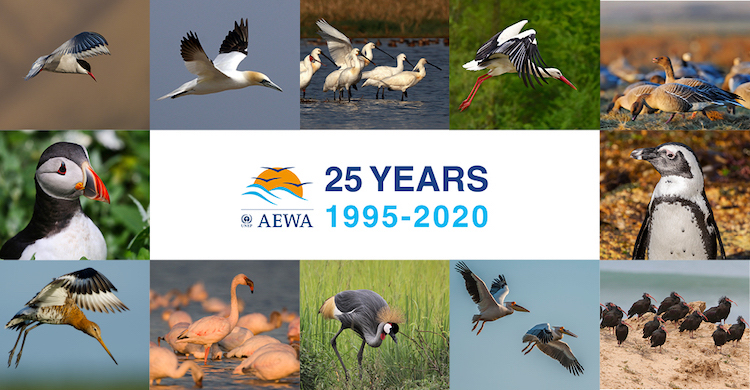
“Now Is the Time to Invest in and Step Up Action for Nature”
By Rita Joshi
BONN (IDN) – At least 40 per cent of the world’s economy and 80 per cent of the needs of the poor are derived from biological resources. These include diversity within species, between species, and between ecosystems. The richer the diversity of life, the greater the opportunity for medical discoveries, economic development, and adaptive responses to such new challenges as climate change and disastrous viruses such as the COVID-19.
The intergovernmental agreement signed on June 16, 1995, in The Hague, Netherlands, took this into account. Millions of migratory waterbirds that link Africa, Europe and parts of Asia – a geographical range that stretches across 119 countries – have benefitted from the framework of the African-Eurasian Migratory Waterbird Agreement (AEWA).
On its 25th anniversary, AEWA accentuates that it is the largest legally binding instrument concluded under the Convention on the Conservation of Migratory Species of Wild Animals (CMS). As an environmental treaty of the United Nations, CMS provides a global platform for the conservation and sustainable use of migratory animals and their habitats. CMS brings together the States through which migratory animals pass, the Range States, and lays the legal foundation for internationally coordinated conservation measures throughout a migratory range.
As the only global convention specializing in the conservation of migratory species, their habitats and migration routes, CMS complements and co-operates with a number of other international organizations, NGOs and partners in the media as well as in the corporate sector.
The Agreement with currently 80 Contracting Parties, including 38 from Africa and 42 from Eurasia embracing the European Union, allows countries across the African-Eurasian flyway to work together to better conserve and sustainably use more than 550 populations of a total of 255 species of birds ecologically dependent on wetlands for at least part of their annual cycle.
Executive Secretary Jacques Trouvilliez of the African-Eurasian Migratory Waterbird Agreement says: “For a quarter of a century, AEWA has successfully established and implemented internationally agreed conservation measures for a range of migratory waterbirds in an area that stretches from the northern reaches of Canada and the Russian Federation to the southernmost tip of Africa.”
In doing so, AEWA has helped foster the international cooperation that is essential to protecting and sustainably managing migratory waterbird populations and their habitats across borders, he adds.
These include many species of diverse, grebes, pelicans, cormorants, herons, storks, rails, ibises, spoonbills, flamingos, ducks, swans, geese, cranes, waders, gulls, terns, tropic birds, auks, frigate birds and even the southern African penguin.
Countries that have joined AEWA have committed to a series of measures intended to ensure the conservation and sustainable use of the waterbirds covered by AEWA. These measures include a series of actions geared towards protecting and restoring waterbird habitat, managing human activities, engaging in research and monitory as well as carrying out education and capacity-building initiatives that support international conservation efforts.
 Photo: The red knots, medium-sized shorebirds which breed in tundra and the Arctic Cordillera in the far north of Canada, Europe, and Russia (left). Northern gannet seabirds native to the coasts of the Atlantic Ocean, breeding in Western Europe, North America, and the Caribbean. Credit: Pixabay.
Photo: The red knots, medium-sized shorebirds which breed in tundra and the Arctic Cordillera in the far north of Canada, Europe, and Russia (left). Northern gannet seabirds native to the coasts of the Atlantic Ocean, breeding in Western Europe, North America, and the Caribbean. Credit: Pixabay.
“While AEWA’s successes have been significant, the pressures on waterbirds and the wetland and coastal habitats they need to survive continue to grow across the flyway. We must redouble our efforts and we must reach out and engage those whose activities may still be harming waterbrids. The time to invest in and step up our action for nature is now,” alerts Trouvilliez.
The warning comes at a time, when numerous pressures resulting from a growing human population as well as pollution, unsustainable use and illegal killing continue to threaten waterbirds and their habitats across Eurasia and Africa. Climate change is compounding existing threats and is increasingly affecting habitats and migration routes, causing a shift in both migration range and timing.
“AEWA’s strength has been not only to connect governments – its formal signatories – but also to bring together multiple interest groups that all share a common concern for migratory waterbirds: whether they be individuals or organizations; governmental or non-governmental; from north or south. There is no doubt this has reduced the pressure on waterbirds and their wetland habitats,” says David Stroud, a renowned waterbird expert from the United Kingdom and Honorary Patron of AEWA.
To mark the anniversary of the treaty, the AEWA Secretariat has developed a dedicated 25th Anniversary Webpage, which brings together some of the history and highlights of the past 25 years of international waterbird conservation under the Agreement. [IDN-InDepthNews – 17 June 2020]
Top photo credit: AEWA. Centre photo: The red knots, medium-sized shorebirds which breed in tundra and the Arctic Cordillera in the far north of Canada, Europe, and Russia (left). Northern gannet seabirds native to the coasts of the Atlantic Ocean, breeding in Western Europe, North America, and the Caribbean. Credit: Pixabay.
IDN is flagship agency of the Non-profit International Press Syndicate.











